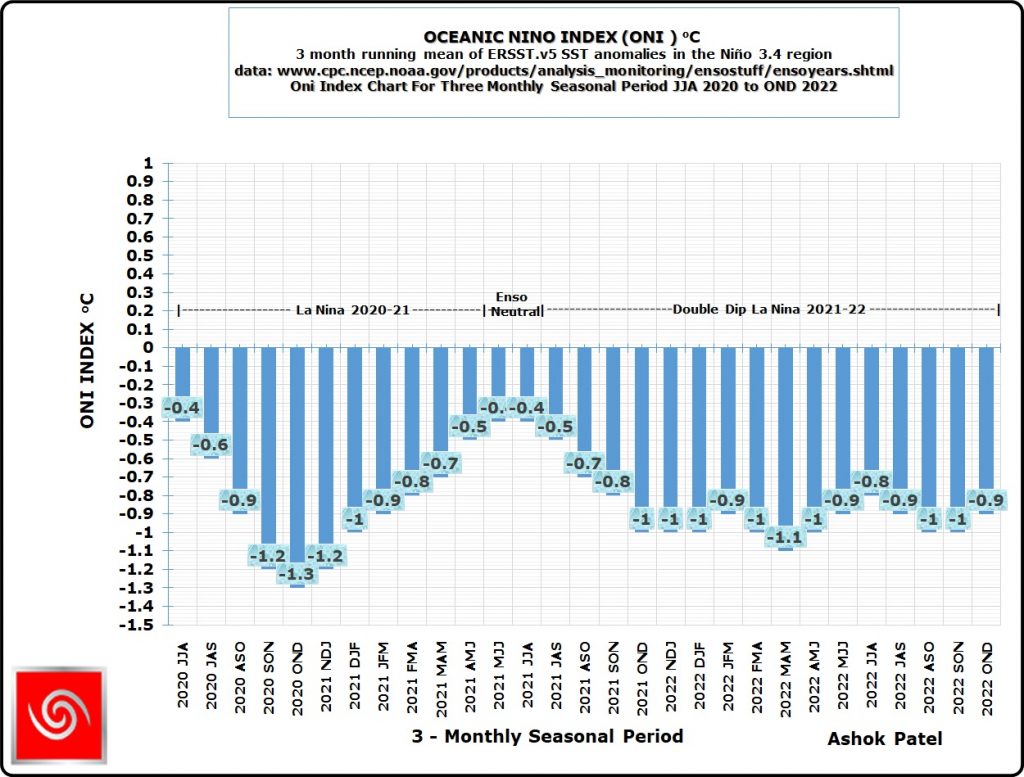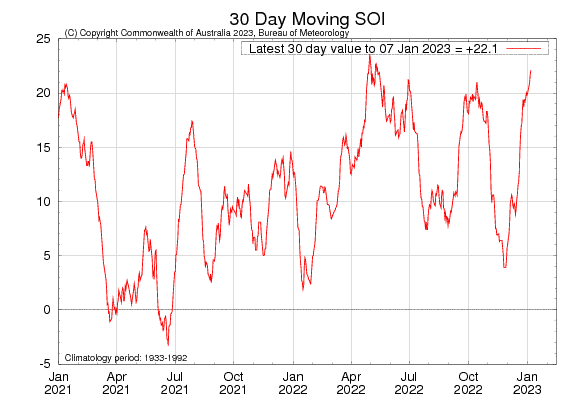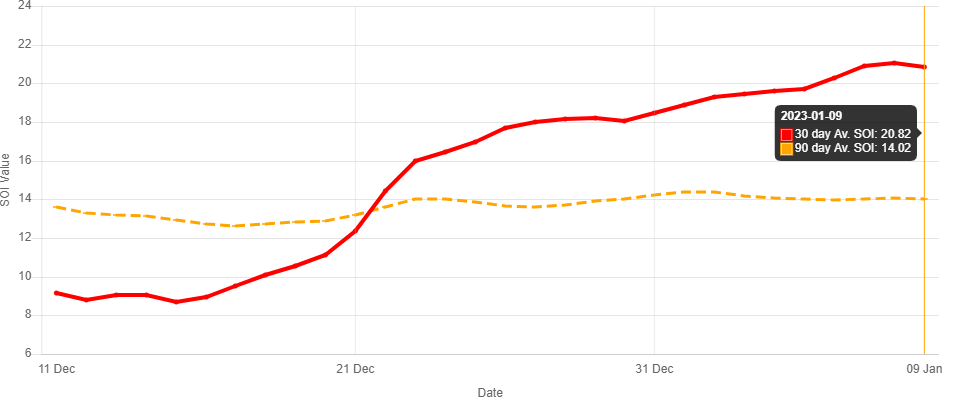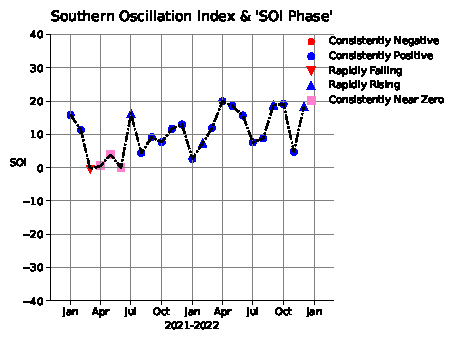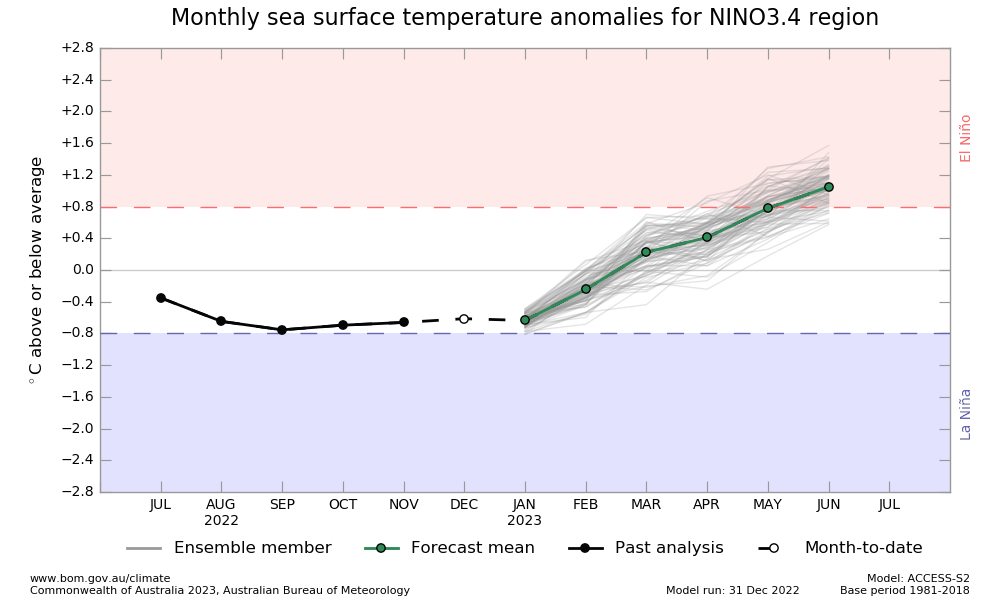Enso Status on 9th January 2023
OND 2022 ONI Index is -0.9ºC. The ‘Double Dip La Nina’ continues to persist at the end of December 2022 and is expected to enter into 2023.
Ashok Patel’s Analysis & Commentary :
Using NOAA Criteria, the La Nina thresh hold was first met in JAS 2021 with Oni Index of -0.5ºC, however, the full fledged La Nina event was confirmed at the end of January 2022 having fulfilled the five consecutive overlapping 3-monthly seasons with ONI less than or equal to –0.5ºC. La Nina has continued for more than a year, December 2022 being the 16th 3-monthly season with OND 2022 at –0.9ºC. This La Nina event is called a ‘Double Dip La Nina’. See https://www.noaa.gov/news/double-dip-la-nina-emerges wherein NOAA mentions “Consecutive La Ninas following a transition through ENSO neutral conditions are not uncommon and can be referred to as a “double-dip.”
The First La Nina event was in 2020-21 which was followed by a second La Nina the current event of 2021-22 with a transition through Enso Neutral Conditions in 2021.
The Double Dip La Nina is expected to enter into 2023.
Indian Monsoon & Enso relationship for India:
Based on earlier more than 100 years weather Data for Indian Summer Monsoon, The Average Rainfall in an El Nino years is 94% of LPA while in La Nina Years it has been 106 % of LPA for the whole country. Monsoon Rainfall over India has been +106% of LPA at the end of 30th September 2022. However, El Nino or La Nina may affect the Monsoon differently for different Regions of India and warrants research for concrete co-relations for each region of India if any.
How ONI is determined:
The ONI is based on SST departures from average in the Niño 3.4 region, and is a principal measure for monitoring, assessing, and predicting ENSO. Defined as the three-month running-mean SST departures in the Niño 3.4 region. Departures are based on a set of further improved homogeneous historical SST analyses (Extended Reconstructed SST – ERSST.v5). Explanation about ERSST.v5 is given here.
NOAA Operational Definitions for El Niño and La Niña, El Niño: characterized by a positive ONI greater than or equal to +0.5ºC. La Niña: characterized by a negative ONI less than or equal to -0.5ºC. By historical standards, to be classified as a full-fledged El Niño or La Niña episode, these thresholds must be exceeded for a period of at least 5 consecutive overlapping 3-month seasons.
CPC considers El Niño or La Niña conditions to occur when the monthly Niño3.4 OISST departures meet or exceed +/- 0.5ºC along with consistent atmospheric features. These anomalies must also be forecast to persist for 3 consecutive months.
The Climate Prediction Center (CPC) is a United States Federal Agency that is one of the NECP, which are a part of the NOAA
Current La Nina 2021-22 all ONI Index are JAS 2021 -0.5ºC ASO 2021 -0.7ºC SON 2021 -0.8ºC, OND 2021 -1.0ºC, NDJ 2022 -1.0ºC, DJF 2022 -1.0ºC, JFM 2022 -0.9ºC, FMA 2022 -1.0ºC, MAM 2022 -1.1ºC, AMJ 2022 -1.0ºC, MJJ 2022 -0.9ºC, JJA -0.8ºC, JAS 2022 -0.9ºC ASO 2022 -1.0ºC SON 2022 -1.0ºC and OND 2022 -0.9ºC.
Latest Oceanic Nino Index Graph Shows
Double Dip La Nina 2021-22 Exists End Of December 2022
The Table below shows the monthly SST of Nino3.4 Region and the Climate adjusted normal SST and SST anomaly from June 2020. Climate Base 1991-2020. ERSST.v5
Period Nino3.4 ClimAdjust YR MON Temp.ºC Temp.ºC ANOM ºC 2020 6 27.39 27.73 -0.34 2020 7 26.99 27.29 -0.30 2020 8 26.27 26.86 -0.59 2020 9 25.89 26.72 -0.83 2020 10 25.46 26.72 -1.25 2020 11 25.28 26.70 -1.42 2020 12 25.45 26.60 -1.15 2021 1 25.56 26.55 -0.99 2021 2 25.76 26.76 -1.00 2021 3 26.50 27.29 -0.80 2021 4 27.11 27.83 -0.72 2021 5 27.48 27.94 -0.46 2021 6 27.45 27.73 -0.28 2021 7 26.90 27.29 -0.39 2021 8 26.32 26.86 -0.53 2021 9 26.16 26.72 -0.55 2021 10 25.78 26.72 -0.94 2021 11 25.76 26.70 -0.94 2021 12 25.54 26.60 -1.06 2022 1 25.61 26.55 -0.95 2022 2 25.88 26.76 -0.89 2022 3 26.33 27.29 -0.97 2022 4 26.72 27.83 -1.11 2022 5 26.83 27.94 -1.11 2022 6 26.98 27.73 -0.75 2022 7 26.60 27.29 -0.70 2022 8 25.88 26.86 -0.97 2022 9 25.65 26.72 -1.07 2022 10 25.73 26.72 -0.99 2022 11 25.80 26.70 -0.90 2022 12 25.71 26.60 -0.89
Summary and Outlook from Various Agencies:
Southern Oscillation Index
As per BOM, Australia:
The 30-day Southern Oscillation Index (SOI) to 7th January 2023 was +22.1 and is considered in the La Nina zone.
Sustained negative values of the SOI below −7 typically indicate El Niño while sustained positive values above +7 typically indicate La Niña. Values between +7 and −7 generally indicate neutral conditions.
Recent (preliminary) Southern Oscillation Index values as per The Long Paddock – Queensland Government.
30 Days average SOI was +18.41 at the end of December 2022 and was +20.82 on 9th January 2023 as per The Long Paddock – Queensland Government and 90 Days average SOI was +14.02 on 9th January 2023.
SOI Monthly graph up to December 2023 as per The Long Paddock – Queensland Government.
Summary by: Climate Prediction Center / NCEP Dated 8th December 2022
ENSO Alert System Status: La Niña Advisory
La Niña is present.*
Synopsis: La Niña is expected to continue into the winter, with equal chances of La Niña
and ENSO-neutral during January-March 2023. In February-April 2023, there is a 71%
chance of ENSO-neutral.
* Note: These statements are updated once a month (2nd Thursday of each month) in association
with the ENSO Diagnostics Discussion, which can be found by clicking here.
As per BOM – Australia 4th January 2023
Enso Outlook
La Niña remains active; however recent observations and model outlooks indicate this event is easing. The Bureau’s latest weekly NINO3.4 value to 01 January 2023 was −0.6 °C, which is outside La Niña thresholds (−0.8 °C and cooler).
All surveyed climate models indicate sea surface temperatures in the central tropical Pacific (NINO3.4) will return to ENSO-neutral by February 2023 and remain at neutral levels until at least the end of the southern hemisphere autumn. Model accuracy is generally lower at this time of year than at other times, so outlooks through and beyond autumn should be viewed with caution.
(Note: Autumn is with reference to Southern Hemisphere)
